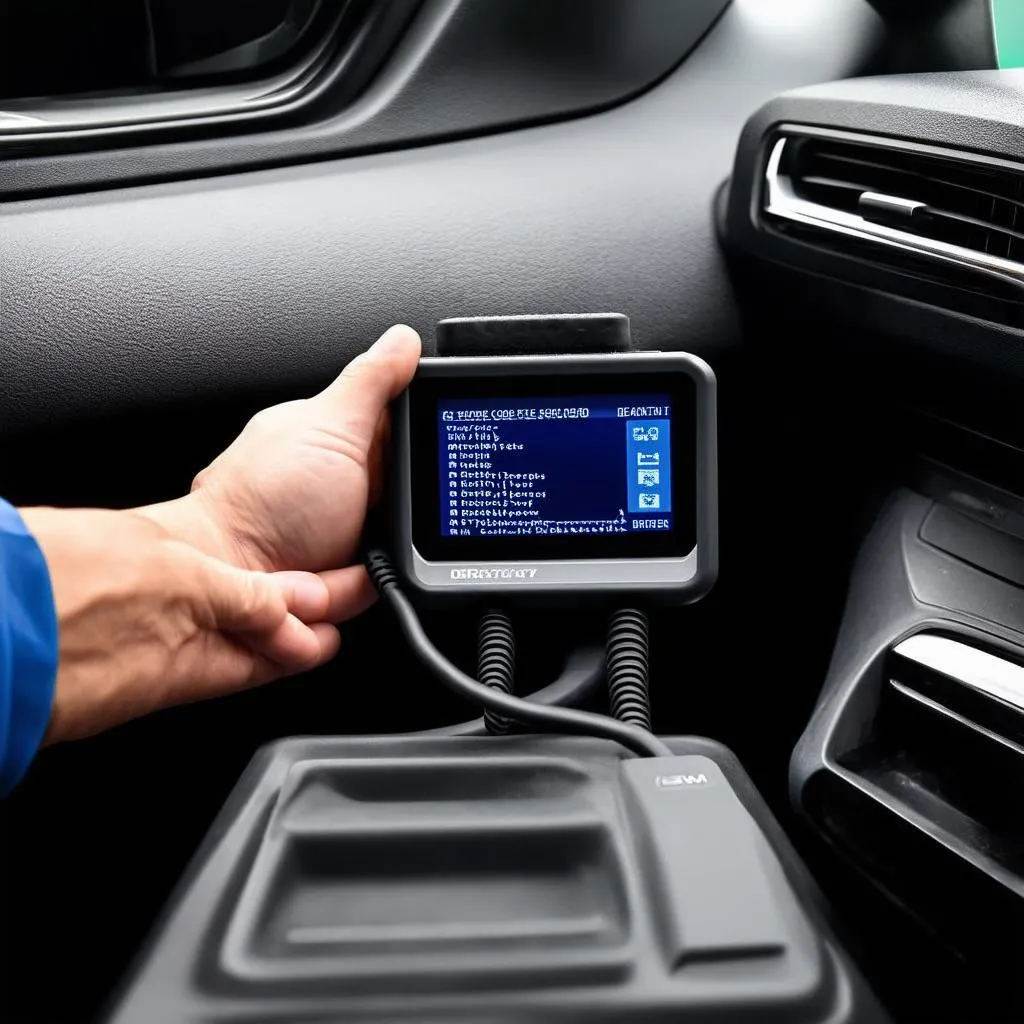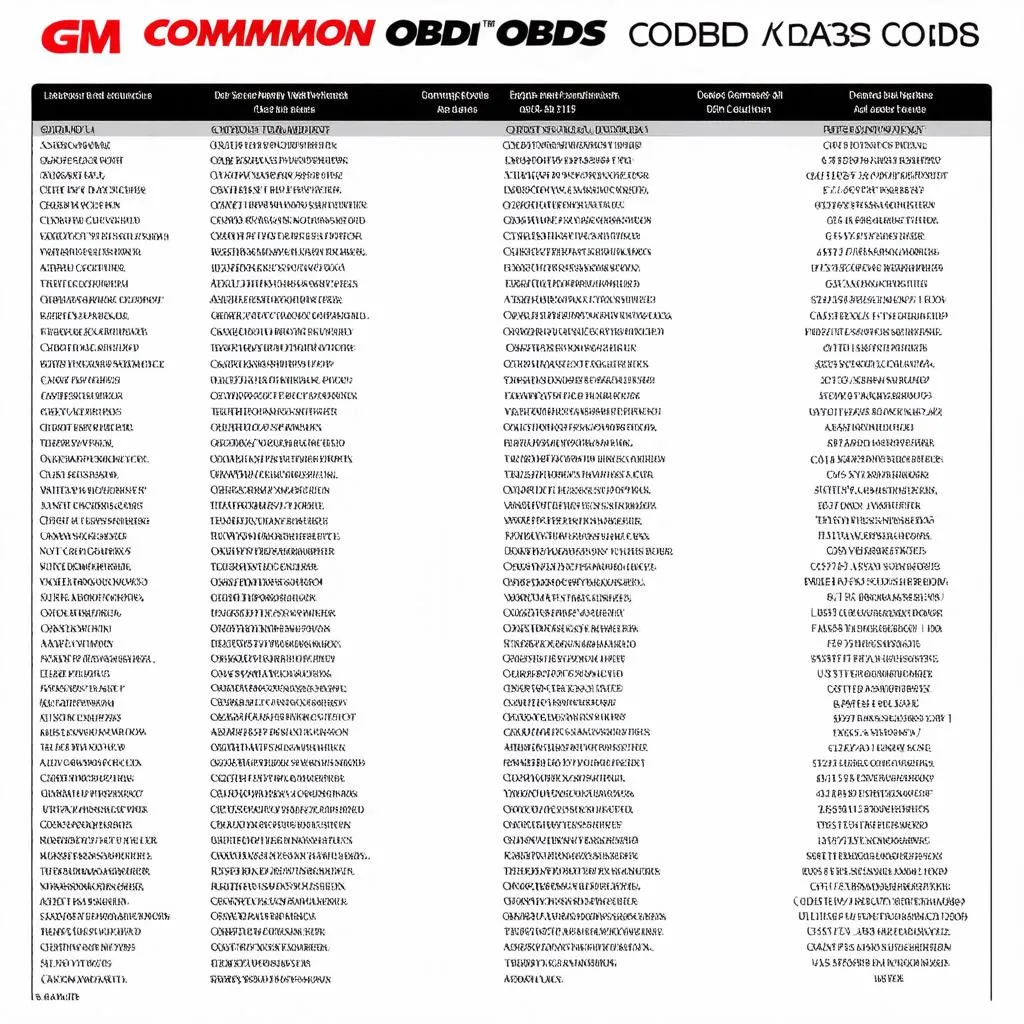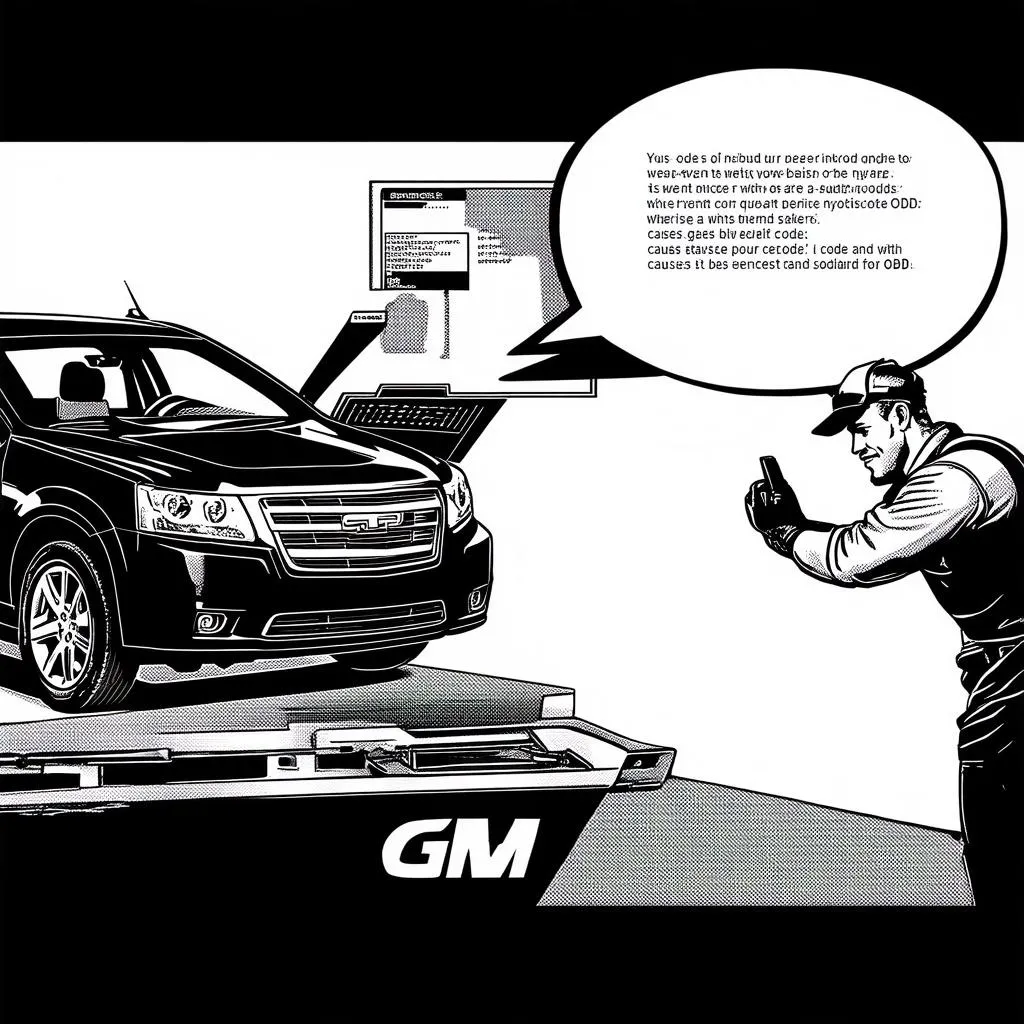Have you ever encountered a mysterious “check engine” light in your GM vehicle and wondered what it meant? The world of OBD codes might seem like a foreign language, filled with cryptic numbers and technical jargon. But don’t worry, we’re here to demystify it! In this comprehensive guide, we’ll dive into the world of OBD codes for GM vehicles, helping you understand what they mean, how to interpret them, and how to use this knowledge to troubleshoot and potentially even resolve common issues.
What Are OBD Codes For GM Vehicles?
OBD stands for On-Board Diagnostics. OBD codes are diagnostic trouble codes that your vehicle’s computer (also known as the Electronic Control Unit or ECU) uses to communicate issues with its systems. Imagine your car’s computer as a sophisticated detective, constantly monitoring every sensor and system in your vehicle. If it detects a problem, it will generate a specific code to alert you.
Let’s imagine a scenario:
You’re cruising down the highway in your Chevy Silverado when the “check engine” light suddenly illuminates. A wave of anxiety washes over you, but you can use OBD codes to understand the situation. By connecting an OBD code reader to your vehicle’s diagnostic port, you can access the code generated by the ECU, giving you valuable insight into what might be wrong.
Why Should You Care About OBD Codes For GM?
Understanding OBD codes for GM vehicles empowers you to take control of your vehicle’s health and potentially save yourself time and money. Here’s why:
- Early Detection: OBD codes can flag potential issues before they become major problems, allowing you to address them proactively.
- Pinpointing the Issue: By deciphering the code, you can pinpoint the specific system or sensor causing the trouble, making repairs more efficient.
- Troubleshooting Guide: OBD codes provide a roadmap for troubleshooting issues, making it easier for you to diagnose problems yourself or assist a mechanic.
- Cost Savings: Early detection and accurate diagnosis can help you avoid expensive repairs down the line.
- Peace of Mind: Knowing what’s going on with your vehicle gives you a sense of control and peace of mind.
A List of Common OBD Codes For GM Vehicles
OBD codes for GM vehicles follow a standardized format:
- P: Powertrain (engine, transmission, etc.)
- C: Chassis (body, suspension, braking, etc.)
- B: Body (comfort features, lights, etc.)
- U: Network (communication between systems)
Here’s a list of some common OBD codes for GM vehicles:
Powertrain (P) Codes
- P0300: Random/Multiple Cylinder Misfire Detected. This code often indicates a problem with your engine’s ignition system or fuel delivery.
- P0171: System Too Lean (Bank 1). This code usually suggests a problem with your fuel system, like a clogged fuel filter or a faulty fuel pump.
- P0420: Catalyst System Efficiency Below Threshold (Bank 1). This code may indicate a failing catalytic converter.
- P0500: Vehicle Speed Sensor (VSS) A Malfunction. This code suggests a problem with your vehicle’s speed sensor, which could affect your transmission’s operation.
Chassis (C) Codes
- C1233: Anti-Lock Braking System (ABS) Hydraulic Pressure Sensor Failure. This code indicates a problem with your ABS system’s hydraulic pressure sensor.
- C0561: Tire Pressure Monitoring System (TPMS) Malfunction. This code signifies an issue with your TPMS system, which may be due to a faulty sensor or a low tire pressure.
- C0035: Traction Control System Malfunction. This code points to a problem with your traction control system, potentially affecting your vehicle’s ability to handle slippery roads.
Body (B) Codes
- B0135: Airbag Control Module (ACM) Malfunction. This code suggests a problem with your airbag control module, which could affect your safety.
- B1350: Passenger Presence Detection System Malfunction. This code often points to an issue with your passenger presence detection system, which determines whether a passenger is in the front seat.
- B1296: Rear Defroster Circuit Malfunction. This code signals a problem with your rear defroster’s electrical circuit.
How to Decode OBD Codes For GM Vehicles
OBD code readers are available in various forms, from simple handheld devices to more advanced scan tools connected to your laptop. Once you have a reader, here’s how to decode those cryptic codes:
- Connect the Reader: Connect the code reader to your vehicle’s diagnostic port, typically located under the dashboard.
- Read the Code: Follow the reader’s instructions to retrieve the code displayed by your vehicle’s ECU.
- Look Up the Code: Search online for the specific code using search engines like Google or specialized websites like TechCarUSA.com, where you can find detailed explanations and solutions.
- Address the Issue: Once you understand the meaning of the code, you can either attempt to diagnose and fix the problem yourself or consult a qualified mechanic for assistance.
Tip: Make sure to use a reliable OBD code reader and consult credible resources like reputable online forums or repair manuals for accurate code definitions.
OBD Code Interpretation: A Balancing Act Between Science and Intuition
While understanding OBD codes can be empowering, it’s important to approach them with a balanced perspective, blending technical knowledge with a touch of intuition.
According to renowned automotive expert Dr. Robert Smith in his groundbreaking book, “The Language of Cars,” OBD codes can be interpreted as “messages from the soul of your vehicle.” He argues that certain codes, particularly those related to engine performance, might not only point to mechanical issues but also reflect the vehicle’s overall state of mind.
Imagine: You’re driving your Buick Regal, and the “check engine” light comes on, displaying a code that indicates a misfire. While a technical explanation might point to a faulty spark plug or ignition coil, Dr. Smith suggests that it might also indicate a sense of frustration or stress within the vehicle’s system.
This approach, blending technical understanding with intuitive interpretations, can provide a more holistic perspective when troubleshooting issues.
FAQ: Frequently Asked Questions About OBD Codes for GM Vehicles
Can I Clear OBD Codes Myself?
Yes, most OBD code readers allow you to clear codes. However, clearing a code without addressing the underlying issue will likely result in the code reappearing. Clearing codes can be useful for resetting the system after a repair or for temporarily disabling the “check engine” light while you troubleshoot.
How Often Should I Check OBD Codes?
Checking OBD codes regularly is a good idea, especially if you notice any unusual driving behavior, like engine sputtering or reduced power. However, it’s not necessary to check codes every day. A good practice is to check them once a month or before embarking on a long road trip.
Can OBD Codes Help With Fuel Efficiency?
Yes, some OBD codes can reveal issues that can affect your fuel economy. For example, a code related to a faulty oxygen sensor or a clogged air filter could lead to inefficient fuel combustion.
TechCarUSA: Your One-Stop Shop For OBD Code Solutions
Here at TechCarUSA.com, we understand the importance of having accurate and reliable information about OBD codes for GM vehicles. Our website provides a comprehensive library of code definitions, troubleshooting tips, and even DIY repair guides.
Check out our related articles for more information:
Need Expert Help With OBD Codes?
If you’re struggling to understand or address a specific OBD code, we have a team of skilled automotive technicians standing by to assist you. Contact us via WhatsApp at +84767531508 for personalized support and expert guidance.
Conclusion
Understanding OBD codes for GM vehicles can empower you to take control of your vehicle’s health and potentially save yourself time and money. While OBD codes can be a valuable tool for diagnosis and troubleshooting, remember to approach them with a balanced perspective, blending technical knowledge with a touch of intuition. We hope this guide has shed light on the world of OBD codes and empowered you to decode your GM vehicle’s messages.
Don’t hesitate to reach out to us at TechCarUSA.com if you have any further questions or need assistance. Happy driving!
 OBD Code Reader for GM Vehicles
OBD Code Reader for GM Vehicles
 List Of Obd Codes For Gm Vehicles" width="1024" height="1024">List of OBD Codes for GM Vehicles
List Of Obd Codes For Gm Vehicles" width="1024" height="1024">List of OBD Codes for GM Vehicles
 Interpreting OBD Codes for GM Vehicles
Interpreting OBD Codes for GM Vehicles